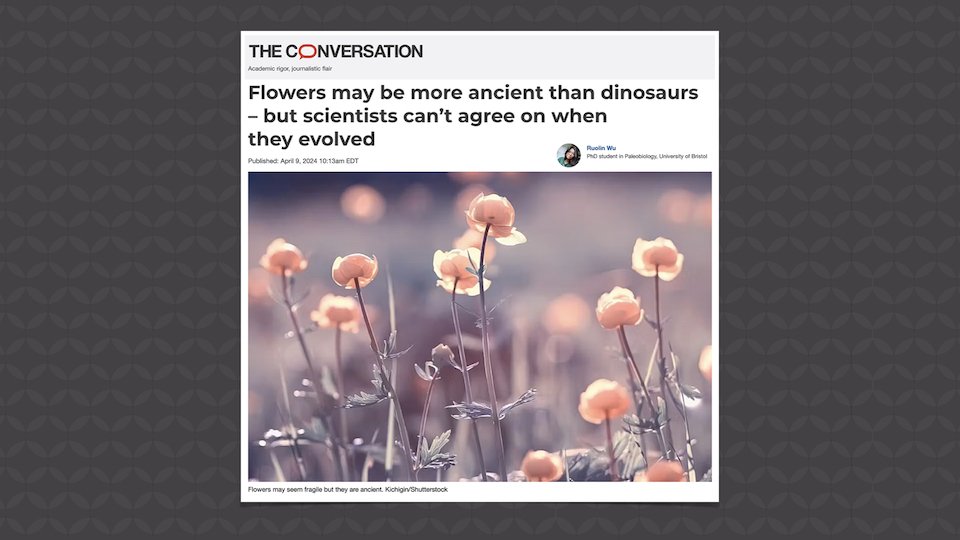
Debunking Evolutionary Timelines for Flowering Plants
When did flowering plants arrive on earth?
Well, according to the Bible, God made all the plant kinds on day three of creation, including flowering ones as well as gymnosperms (like evergreen trees). However, the evolutionary model is not nearly so clear. Evolutionists remain unsure when the angiosperms (flowering plants) emerged.
Originally, they did not believe flowering plants and dinosaurs coexisted. However, fossils, particularly fossils of pollen, began pushing flowering plants further and further back into the imaginary millions of years of history that evolution needs to survive. According to a The Conversation article, written by a doctoral student in paleontology, flowers may have coexisted with dinosaurs.
Of course we know, biblically, that what we today call dinosaurs were made on day six and that therefore, as long as dinosaurs were alive, they coexisted with flowering plants.
Of course we know, biblically, that what we today call dinosaurs were made on day six and that therefore, as long as dinosaurs were alive, they coexisted with flowering plants. However, there is significant debate among evolutionists as to when flowering plants actually arose. The timing of the evolution of flowering plants is still a matter of debate between scientists, but most scientists are in one of two camps: Jurassic (allegedly 201–140 MYA) or Cretaceous (140–66 MYA). Ironically, the most prodigious pollinator, the bee, is not thought to have evolved until 120 MYA, so this seems to (from an evolutionary standpoint) necessitate that flowering plants didn’t originate until the Cretaceous.
Bad Timing
One way evolutionists try to determine how old angiosperms are is by using something called a molecular clock. A molecular clock uses DNA sequences to see how closely related two species are. According to the molecular clock idea, since mutations tend to occur roughly at the same rate over time, we can determine how long two species have been separated by counting the number of mutations—provided we know the mutation rate.
To use a molecular clock, you have to make some assumptions. The first assumption is that the two species you are comparing are related. For evolutionists, this is not a problem since they think all life is related. Since they are wrong about that, many of their molecular clock results are in error.
Assuming that the first assumption is met, there remains the assumption that mutation rates are constant through time. That may or may not be true, and there is certainly no way to test the mutation rate of an extinct, supposedly sixty-million-year-old plant. Further, it assumes that the mutation rate is the same across the entire genome. We know this is false in humans, as humans have mutational hotspots where mutations occur more frequently than expected. It is possible plants might have similar hotspots.
Despite the drawbacks of the molecular clock, evolutionists have used them to test when angiosperms and gymnosperms, the supposed nearest relation of angiosperms, split from each other. This date is important to evolutionists because it represents the potential origin of the first angiosperms and therefore the first flowers.
There are other methods that are used to try to figure out when the first flowers emerged. The Conversation cites a method called the Bayesian Brownian Bridge: “This statistical model is a scientific formula that uses the distribution of fossils through time to estimate the age of a group.” The rather obvious potential problem here is statistical methods are only as good as the data you feed them. If you feed them evolutionary data, you’ll get sloppy evolutionary “results” in return. Which is precisely what happened in the study The Conversation cites, which, they claim, shows flowers evolved at roughly the same time as dinosaurs during the Jurassic, which is at odds with the supposed origin of bees during the Cretaceous.
When you start from the sure foundation of the Word of God, explaining the origin of flowers and flowering plants in general becomes easy.
There Is a Book
From a biblical perspective, we know that God made flowers and flowering plant kinds (including fruit and vegetable varieties) before dinosaurs, so their evolution-biased analysis is wrong. Flowering plants actually predate dinosaurs . . . though only by three days (Genesis 1:11–13, 1:24–25). And God made flower pollinators (mostly winged insects, birds, and bats) on day five of creation week. When you start from the sure foundation of the Word of God, explaining the origin of flowers and flowering plants in general becomes easy.
Get More Answers on Answers News
This item was discussed Monday on Answers News with cohosts Dr. Georgia Purdom, Rob Webb, and Jessica DeFord. Answers News is our weekly news program filmed live before a studio audience here at the Creation Museum, broadcast on our Answers in Genesis YouTube channel, and posted to Answers TV. We also covered the following topics:
- Transgender biological male athletes banned from women’s sports?
- Are Gen X’s attitudes toward evolution changing?
- Is the universe’s expansion slowing down?
- And more!
Be sure to join us each Monday at 2 p.m. (ET) on YouTube or later that day on Answers TV for Answers News. You won’t want to miss this unique news program that gives science and culture news from a distinctly biblical and Christian perspective.
Thanks for stopping by and thanks for praying,
Ken
This item was written with the assistance of AiG’s research team.
Most Recent News
-
April 29, 2024 from Ken Ham Blog
Praise God for parents and organizations in Queensland for coming together and actually keeping their children’s “safety” and “wellbeing” in mind.
-
April 25, 2024 from Ken Ham Blog
A recent article made the bold claim that feathers are one of evolution’s greatest inventions. But what proof did they offer?

Answers in Genesis is an apologetics ministry, dedicated to helping Christians defend their faith and proclaim the good news of Jesus Christ.
- Customer Service 800.778.3390
- © 2024 Answers in Genesis



